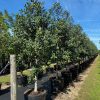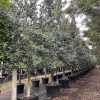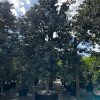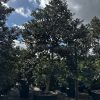Description
Ficus Rubiginosa, commonly known as the rusty fig or Port Jackson fig, is a species of evergreen tree that is a member of the Moraceae family, along with the Banyan tree (Ficus Benghalensis), Florida Strangler fig (Ficus Aurea), and Sacred Fig (Ficus Religiosa) Native to Australia, the Ficus rubiginosa (Rusty Fig) may be found primarily in the eastern states, including New South Wales, Victoria, and Queensland. The tree thrives in a variety of environments, from rainforests and woodlands to rocky outcrops and sandy shores.
Flowering and Foliage of the Ficus Rubiginosa Tree
The rusty fig tree is a medium to large-sized tree that can grow up to 65 feet tall. It has a rounded to spreading canopy that provides ample shade. The tree has a single trunk that can grow up to 3 feet in diameter, with a smooth, gray-brown bark that becomes fissured and scaly as it ages. The branches are sturdy, spreading, and often covered with small figs. The Ficus rubiginosa (Rusty Fig) has oval, glossy, dark green leaves that range in size from 2 to 5 inches long and 1 to 3 inches wide. The foliage is dense and provides an ideal habitat for birds and other animals. And, although the tree’s tiny, inconspicuous blossoms are not particularly showy, they are crucial for pollination. The small, juicy, spherical fruits of the rusty fig tree (Ficus Rubiginosa) range in diameter from 0.3 to 0.7 inches. They are green when young, turning brown or reddish-brown when mature. The figs are edible and attract a variety of animals, including birds.
Soil Type and Plant Requirements for the Rusty Fig Tree
The Ficus Rubiginosa (rusty fig) prefers well-drained soils, but it can also grow in clay and sandy soils. It is a hardy tree that can tolerate drought and frost, making it suitable for growing in a wide range of climatic conditions. Although, the best growing conditions for the rusty fig include full sun or partial shade, and regular watering.
Landscape Applications of Ficus Rubiginosa
The rusty fig (Ficus Rubiginosa) tree is a popular ornamental tree in Australia because of its gorgeous leaves and wide canopy. Moreover, it is great to manage erosion and land rehabilitation. The tree grows from seed and from cuttings. In south Florida, its also quite attractive for landscape design as they are stunning, low maintenance trees, with the ability to tolerate a range of soil types and moisture levels. For instance, a huge, spreading tree like the Ficus Rubiginosa (rusty fig) can offer plenty of shade for outdoor places like patios, decks, and picnic areas. Also a well-liked option for planting along sidewalks and roadways because it is low-maintenance and wide tolerance of urban environments. Due to its interesting trunk texture and distinctive branching pattern, the rusty fig is unquestionably a specimen tree. It is also excellent for planting by the seaside due to it is salt-tolerance.
Rusty fig (Ficus Rubiginosa) in Florida
Rusty fig (Ficus Rubiginosa) trees can be seen in South Florida in places like the Fairchild Tropical Botanic Garden in Miami and the University of Miami’s Coral Gables campus, where there are several large specimens on South Florida.














